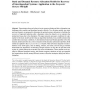Free Online Productivity Tools
i2Speak
i2Symbol
i2OCR
iTex2Img
iWeb2Print
iWeb2Shot
i2Type
iPdf2Split
iPdf2Merge
i2Bopomofo
i2Arabic
i2Style
i2Image
i2PDF
iLatex2Rtf
Sci2ools
ANOR
2016
2016
Static and dynamic resource allocation models for recovery of interdependent systems: application to the Deepwater Horizon oil s
Determining where and when to invest resources during and after a disruption can challenge policy makers and homeland security officials. Two decision models, one static and one dynamic, are proposed to determine the optimal resource allocation to facilitate the recovery of impacted industries after a disruption where the objective is to minimize the production losses due to the disruption. The paper presents necessary conditions for optimality for the static model and develops an algorithm that finds every possible solution that satisfies those necessary conditions. A deterministic branch-and-bound algorithm solves the dynamic model and relies on a convex relaxation of the dynamic optimization problem. Both models are applied to the Deepwater Horizon oil spill, which adversely impacted several industries in the Gulf region, such as fishing, tourism, real estate, and oil and gas. Results demonstrate the importance of allocating enough resources to stop the oil spill and clean up th...
| Added | 29 Mar 2016 |
| Updated | 29 Mar 2016 |
| Type | Journal |
| Year | 2016 |
| Where | ANOR |
| Authors | Cameron A. MacKenzie, Hiba Baroud, Kash Barker |
Comments (0)

